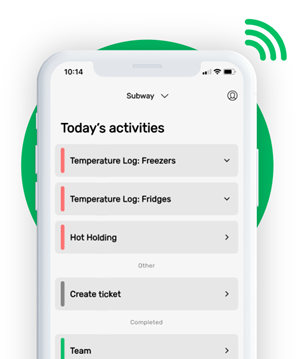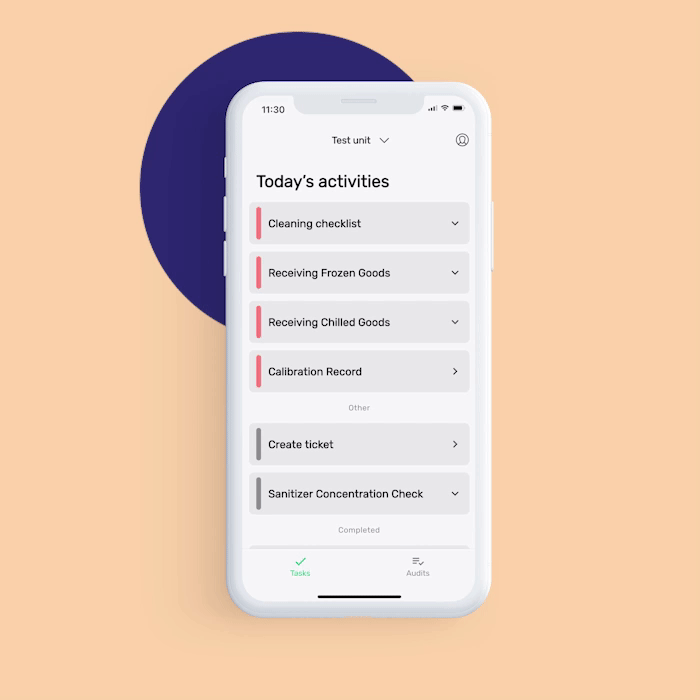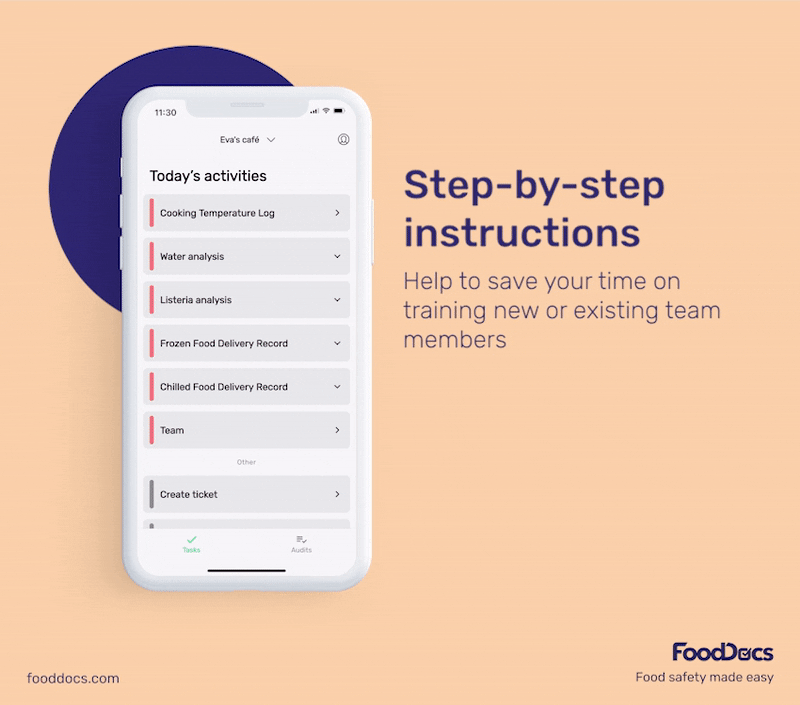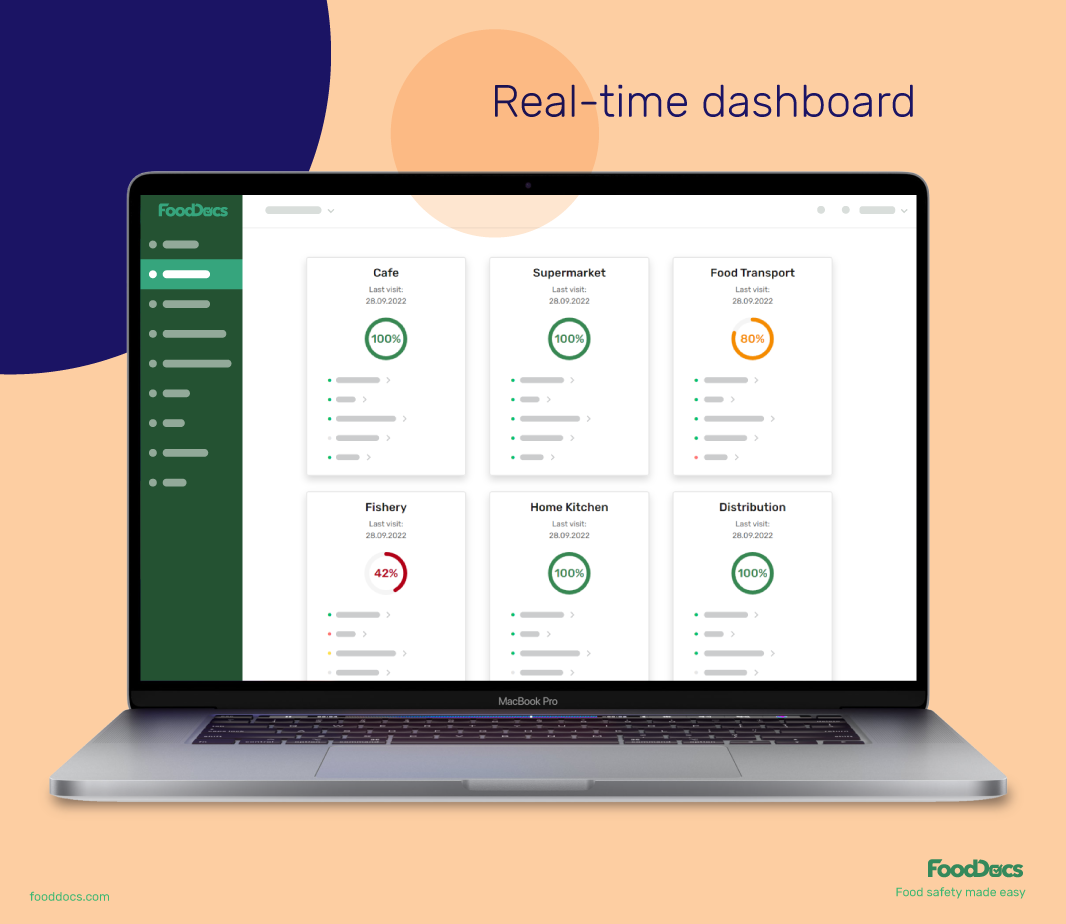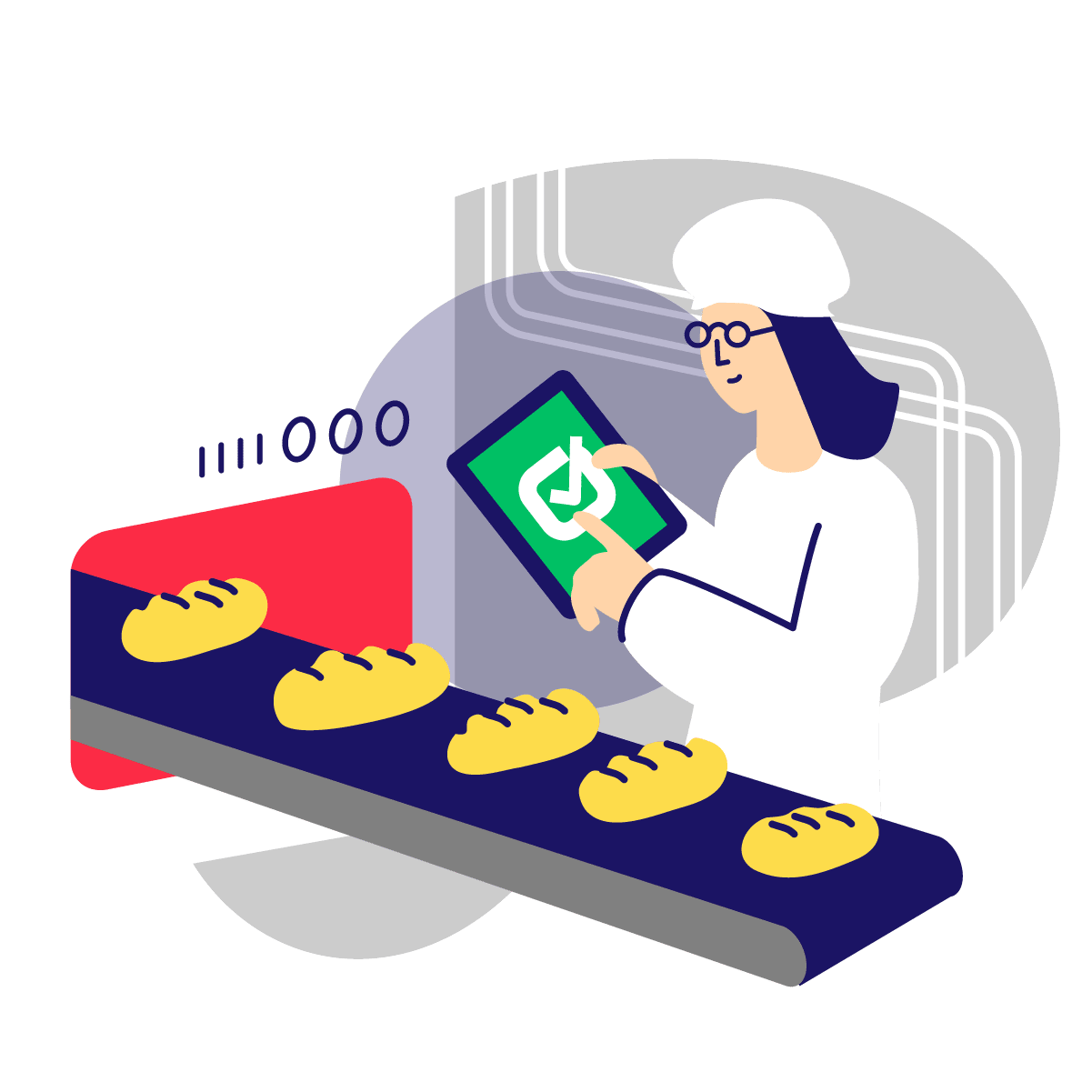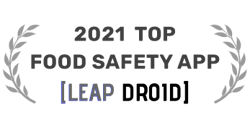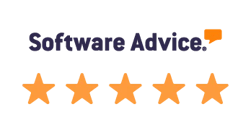RESTAURANT CLEANING CHECKLIST TEMPLATE
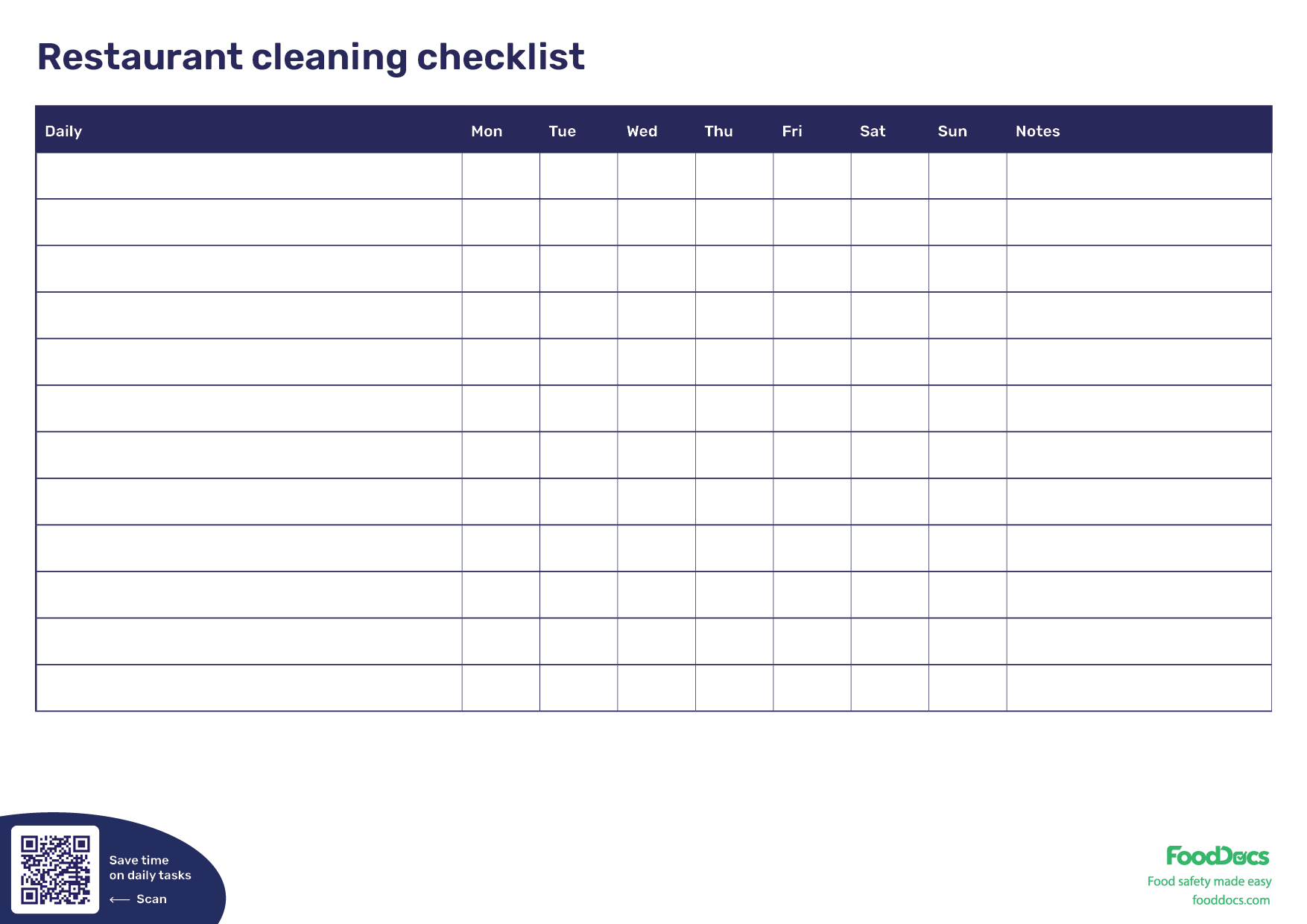


This is how our Digital Food Safety platform saves 20% of your time on daily tasks:
- Get upcoming task notifications
- Add data into the app
- Check the status of tasks in real-time

When food safety was still handled on paper, I typically spent a couple of hours per day getting the papers and going around checking or completing tasks… Now I can sit down and it's just all there in one place. It takes me 5-10 minutes.
Ruth B.
Store Manager
Use the restaurant cleaning checklist template above to help your food safety team remember all cleaning and sanitizing tasks, and ensure that all daily, weekly, and monthly tasks are done on time.
Key takeaways
-
- A restaurant cleaning checklist is a useful tool to remind your staff of all the essential cleaning activities needed to be done to avoid cross-contamination.
- Regularly cleaning your restaurant keeps food safety issues from occurring and promotes your business to consumer liking.
- The majority of consumers tend not to come back if they observe bad hygiene and unclean facilities in a restaurant.
- All food businesses, including restaurants, retail stores, and food manufacturing companies, would benefit from a cleaning checklist.
- Cleanliness is a minimum requirement for any type of food business.
- A Restaurant Cleaning Checklist must include properly categorized tasks, frequencies, and a section to write the responsible employee.
- FoodDocs' smart Food Safety Management System automatically generates digital cleaning checklists equipped with detailed instructions on how to perform them.
- FoodDocs' customizable smart software features a real-time dashboard that shows the status of cleaning tasks and helps save time on supervision.
How to Use a Restaurant Cleaning Checklist Template
A restaurant cleaning checklist helps organize and remind food handlers of all cleaning and sanitation tasks. It ensures that tasks are categorized based on how often they must be done.
Here are some quick steps to using to use the free printable Restaurant Cleaning Checklist:
- Insert your company name.
- Categorize all cleaning tasks according to their schedule (e.g., daily, weekly, monthly)
- Review all pre-entered tasks on the checklist and customize them according to your cleaning schedule.
- Add more rows as needed.
- Enter a valid email address.
- Click "Download."
This restaurant cleaning checklist will give you blank daily, weekly, and monthly templates. Go here for the customizable restaurant cleaning checklist instead to save time on filling them in yourself.
If it doesn't appear automatically, check your Downloads folder. Print the checklist and maintain a control file of this document. Orient your team on who needs to do a particular task and how to mark if it was successfully performed.
You can also upgrade your Restaurant Cleaning Checklist and pair it with smart tools from FoodDocs. Get automatically generated cleaning checklists and other monitoring logs equipped with detailed instructions.
Using a digital restaurant cleaning checklist can bring numerous benefits to your food business. For one, it increases efficiency and productivity by automating reminders and notifications for upcoming tasks. This ensures that your staff never misses a critical cleaning task, reducing the risk of contamination and maintaining a clean environment for your customers.
Digital checklists also improve accuracy and reduce errors by providing a clear and concise list of tasks to be completed. This helps to minimize misunderstandings and ensures that all staff members are on the same page. Additionally, digital checklists can be easily shared and accessed across teams and locations, making it simple to implement a standardized cleaning protocol across your entire operation.
Another significant advantage of digital checklists is enhanced staff accountability and tracking. With a digital system, you can easily monitor progress and identify areas where staff may need additional training or support. This helps to promote a culture of accountability and ensures that all staff members are taking their cleaning responsibilities seriously.
Finally, digital checklists offer customization and flexibility, allowing you to adapt your cleaning schedule and protocols to changing circumstances. This might include adjusting your cleaning frequency during peak periods or implementing new cleaning protocols in response to changing regulations or customer expectations.
Simplifying Restaurant Cleaning Checklist Tasks with a Ready-to-Use Template
Keeping all food contact surfaces clean is an important job in the food service industry. Food safety agencies and health inspections all over the world require all food businesses to conduct cleaning routines daily to control food safety.
These cleaning tasks range from removing food stains on the tables and walls to properly segregating all waste. Keep all tasks organized and never miss one by having a restaurant cleaning checklist around.
All the cleaning tasks need a certain level of attention to achieve standard cleanliness. They must also be performed regularly to become effective, and proper cleaning products must be used. It has been reported that at least 88% of customers become worried about the food they get when they see a dirty restaurant.
WHAT WE'LL COVER:
- What is a restaurant cleaning checklist?
- Who needs a restaurant cleaning checklist?
- What is the importance of a restaurant kitchen cleaning checklist?
- What should an employee restaurant cleaning checklist include?
- How can I help my team ensure compliance with cleaning tasks?
- Cleaning checklist to stay food safety compliant
- Customizable management system for an efficient transition
- Step-by-step instructions to help perform tasks
- Real-time overview to save time from supervision
- Frequently Asked Questions (FAQs)
What is a Restaurant Cleaning Checklist Template?
A Restaurant Cleaning Checklist is a helpful tool that contains a list of cleaning activities essential to control food safety. This checklist highlights all the cleaning protocols you need to routinely do as maintenance to your facilities to prevent food contamination.
Because of the many other tasks needed in a restaurant, such as preparing the meals, serving them to the customers, and maintaining customer service, teams can neglect their cleaning activities.
A Restaurant Daily Cleaning Checklist highlights the importance of all activities indicated in it. It shows how food safety can be risked if any task is forgotten or missed.
Maintaining restaurant cleanliness in your facilities and the commercial kitchen equipment you use is perhaps one of the best customer services you can provide. A clean restaurant attracts consumers and shows them your commitment to serving hygienic products and services.

Best practices for creating and implementing a restaurant cleaning checklist
Creating and implementing an effective restaurant cleaning checklist requires careful planning and attention to detail. Here are some best practices to keep in mind:
- First, identify the key areas and tasks that need to be included in your checklist. This might include daily, weekly, and monthly cleaning tasks, as well as specific protocols for handling food, cleaning equipment, and maintaining customer areas.
- Next, determine the frequency of cleaning for each task. This will help you to create a schedule that ensures all areas of your restaurant are cleaned regularly and consistently.
- Assign responsibilities and tasks to specific staff members. This helps to promote accountability and ensures that all staff members understand their role in maintaining a clean and safe environment.
- Establish a system for tracking and monitoring progressl. This might include using a digital checklist or log to record completed tasks and identify areas where additional attention is needed.
- Finally, regularly review and update your checklist to ensure it remains relevant and effective. This might involve soliciting feedback from staff and customers, as well as staying up-to-date with changing regulations and industry best practices.
Who needs a Restaurant Cleaning Checklist?
All types and sizes of food businesses may benefit from a Restaurant Cleaning Checklist. Whether the business is in manufacturing, retail, or food service, an employee Restaurant Cleaning Checklist is necessary.
Your food business will benefit from such a checklist by maintaining food safety consistently.
For a small business, most cleaning tasks are done personally by the staff without the help of third-party cleaning services.
A Restaurant Cleaning Checklist will help the employees remember which tasks must be fulfilled in each service schedule. On the other hand, tasks are more specific for bigger businesses but will cover a wider range of activities. As such, they may benefit from a focused and specific cleaning checklist to enhance efficiency.
A cleaning checklist can be distributed to the different sections of your food business. The different parts of your business may require different tasks when it comes to cleaning. Restrooms require stronger cleaning materials, whereas your food preparation area requires mild to food-grade materials.
Some of the areas which need a separate cleaning checklist in your food business include:
- Kitchen area (e.g., food contact surfaces, floors, and stove area)
- Restrooms
- Counter area
- Walk-in refrigerators
- Storage area
- Service area
- Receiving area
Each section within an area will require some specific cleaning tasks. A daily Restaurant Cleaning Checklist will help your staff and supervisors determine which ones need to be done daily; a monthly restaurant cleaning checklist will help your team monthly.
In addition to a clean environment for service, a comprehensive Restaurant Cleaning Checklist template can help maintain staff accountability by assigning staff to specific tasks.

What is the importance of a Restaurant Kitchen Cleaning Checklist?
Regular cleaning can become overwhelming if you don't have a proper system with all relevant food safety checklists. Having cleaning records is useful because it helps you and your staff stay organized and keep on top of your food safety management system and guidelines.
Here are some benefits you can get from a printable Restaurant Kitchen Cleaning Checklist:
- Reminders: A restaurant cleaning schedule determines which jobs should be done, how often, and which supplies to use, whereas a cleaning checklist template puts the cleaning schedule into action - it's for your staff to remember all the cleaning tasks and the details. Having a restaurant cleaning checklist works way better than using notepads as reminders.
- Organization: As the frequency of the tasks is different, a cleaning sanitation checklist helps you work in an orderly manner. An organized Restaurant Cleaning Checklist can help your staff do their job efficiently. Some steps must be done before the others, such as wiping kitchen walls from top to bottom to prevent the reoccurrence of dirt.
- Staff accountability: A Restaurant Kitchen Cleaning Checklist can serve as a copy of which staff is assigned a task. This makes progress and accountability tracking easier for a supervisor.
- Increased food safety: By reminding your staff to practice correct cleaning practices, your team can control potential food safety hazards like cross-contamination that can contaminate your food operations. In return, consumers and health inspectors will recognize your efforts and commitment to food safety.
- Promotes proactivity: Having a Restaurant Cleaning Checklist builds a proactive food safety culture by reviewing the list for any due tasks. This aspect can be passed down to all employees and can even improve their way of living.
- Improve management: By becoming more organized, you can focus more on managing your business while you review if the tasks have been done accordingly using a Restaurant Cleaning Checklist. You do not have to ask each assigned staff whether the task was done or not.
A Restaurant Kitchen Cleaning Checklist is crucial in maintaining cleanliness, hygiene, and food safety standards within the establishment. It ensures that all necessary cleaning tasks are consistently performed, minimizing the risk of cross-contamination, foodborne illnesses, and other health hazards.
What should a Restaurant Cleaning Checklist include?
Every type of restaurant will eventually end up with a unique Restaurant Cleaning Checklist. A restaurant that serves seafood may need a different cleaning routine to satisfy food safety standards when compared to a food business specializing in pastries.
Differences in the frequency of specific cleaning tasks are also expected for each type of restaurant. As such, a good Restaurant Cleaning Checklist must be versatile and comprehensive.
Here are some components that a comprehensive restaurant cleaning checklist should have:
- Properly categorized tasks. This component tells you which tasks must be done for your restaurant operations. Each section of your entire restaurant will also require different cleaning tasks, therefore, must include specific information.
General cleaning tasks
- Wipe down walls and entrance doors from food stains
- Remove all unclean dishes from the bussing area
- Clean coffee makers
- Clean hood filters
- Clean chairs and decorative wall hangings
- Clean windows
- Sweep and wipe floors
- Empty trash bins/trash cans
- Clean waste disposal
- Change or clean floor mats
- Monitoring pest traps
Restaurant kitchen cleaning tasks
- Drain pans and ice machines
- Clean condiment racks
- Clean food prep stations, and food prep surfaces, and clean the kitchen floor
- Clean prep area surfaces, including stainless steel surfaces
- Sanitize cooking table
- Remove grease buildup on walls
- Clean stove area
- Clean grease traps
- Clean oven
- Clean refrigerator coils
- Clean washing machine and washing stations
- Take the trash bags out
Restaurant service area cleaning processes
- Clean and wipe all chairs, table tops, and glass doors
- Clean coffee machine and espresso machine
- Replenishing paper towel dispensers
- Collect dirty towels
- Remove any spilled food residue on the floor
- Sanitize tables and pepper shakers
- Clean vent hoods
- Emptying trash and recycling bins
- Dust ceiling fans
- Take the trash bags out
Storage area
- Remove all ingredients that are past their expiration dates
- Arrange similar ingredients with newer stocks at the back, and the older ones in front: First-In, First-Out (FIFO)
- Established frequency of cleaning. Your restaurant cleaning schedule checklist must categorize which cleaning tasks must be done daily, weekly, or monthly. Not all tasks need to be done daily. This routine can become very inefficient and a waste of effort and cleaning materials.
Categorize high-risk tasks such as sanitizing the preparation table and changing fryer oil daily since these cleaning activities are required to control food safety. Weekly tasks can include dusting off light fixtures, sanitizing doors, removing clogs from the grease traps of the deep fryer, and replenishing big condiment containers.
Additionally, some tasks only require to be done once a month, which usually involve deep cleaning. Such tasks may include knocking off cobwebs, changing hood filters, replacing light fixtures, sanitizing the walls, defrosting freezers, and cleaning refrigerator coils.
Each restaurant will most likely require specialized daily cleaning tasks with varying frequencies.
- A section for remarks/ Assigned staff. In addition, your Restaurant Cleaning Checklist can have an additional column for remarks which need to be noted. These remarks can be any unusual event that happened during the execution of the task or any important reminder that needs to be relayed to a supervisor or the next shift.
Some remarks can include replenishing any cleaning solution, broken fixtures that need to be replaced immediately, observing expired raw materials, and reporting a sighting of rodents dropping to alert pest control.
Alternatively, this extra column can serve as a section for your supervisor to sign, acknowledging that the tasks have been reviewed accordingly.
Restaurant cleaning checklist template examples
As an example, here are some tasks you can add according to how our free restaurant cleaning checklist template is categorized to get started.
Daily Kitchen Cleaning Checklist:
- Clean and sanitize all food preparation surfaces
- Sweep and mop floors
- Clean and sanitize all utensils and equipment
- Take out the trash and recycling
Weekly Restaurant Cleaning Checklist:
- Dust and clean all customer areas, including tables, chairs, and decor
- Clean and sanitize all restrooms
- Clean and sanitize all kitchen equipment,
- including ovens, stoves, and refrigerators
- Mop all floors
Monthly Deep Cleaning Checklist:
- Deep clean all kitchen equipment, including ovens, stoves, and refrigerators
- Clean and sanitize all walls and ceilings
- Clean and sanitize all windows and doors
- Deep clean all customer areas, including tables, chairs, and decor
These are just a few examples of the types of checklists you can use to maintain a clean and safe environment in your restaurant. Remember to customize your checklists to fit the unique needs and circumstances of your business.
You can access more monitoring log templates, checklists, posters, charts, and advisories from our food safety templates hub.
What are the common challenges and solutions for implementing a restaurant cleaning checklist?
Implementing a restaurant cleaning checklist can be challenging, especially if your staff is not used to following a standardized cleaning protocol. Here are some common challenges you might encounter, along with some potential solutions:
1. Resistance to change
If your staff is not used to following a cleaning checklist, they may be resistant to the new protocol. To overcome this, provide training and education on the importance of cleaning protocols and the benefits of using a checklist. This can help to build buy-in and encourage staff to take ownership of their cleaning responsibilities.
2. Limited resources or budget for cleaning supplies and equipment
Prioritize your cleaning tasks and focus on the most critical areas of your restaurant to tackle this challenge. You can also explore cost-effective cleaning solutions and supplies that meet your needs without breaking the bank.
3. Difficulty in tracking and monitoring progress
Overcome this by using a digital checklist or log to record completed tasks and identify areas where additional attention is needed. This can help to promote accountability and ensure that all staff members are taking their cleaning responsibilities seriously.
4. Struggling to maintain consistency across multiple locations or teams
Establish a standardized cleaning protocol that can be implemented across all locations and teams. This can help to ensure consistency and promote a culture of cleanliness and safety across your entire operation.
What should a food safety manager know about regulations and standards for restaurant cleaning and sanitation?
As a restaurant owner or manager, it's essential to stay up-to-date with the latest regulations and standards for restaurant cleaning and sanitation. Here are some key regulations and standards to be aware of:
- Local and national health codes: These codes provide guidelines for maintaining a clean and safe environment in your restaurant. They may include requirements for cleaning frequencies, sanitation protocols, and pest control.
- FDA guidelines for food safety and sanitation: The FDA provides guidelines for food safety and sanitation, including requirements for cleaning and sanitizing food preparation surfaces, utensils, and equipment.
- OSHA regulations for workplace safety and hygiene: OSHA regulations provide guidelines for maintaining a safe and healthy work environment, including requirements for cleaning and sanitizing work surfaces, equipment, and facilities.
Staying up-to-date with these regulations and standards will help ensure you're maintaining a clean and safe environment in your restaurant. This can help to protect your customers, staff, and reputation while also avoiding fines and penalties for non-compliance.
How can I measure and evaluate the effectiveness of a restaurant cleaning checklist?
Use these tips to help measure and evaluate how effective your restaurant cleaning checklist is on a regular basis:
- Track metrics such as cleaning completion rates and staff compliance. This can help you to identify areas where your staff may need additional training or support.
- Conduct regular audits and inspections to ensure adherence to the checklist. This can help to promote accountability and ensure that all staff members are taking their cleaning responsibilities seriously.
- Gather feedback from staff and customers. This can help you to identify areas where your checklist may need to be updated or improved, while also providing valuable insights into the effectiveness of your cleaning protocols.
- Regularly review and update your checklist to ensure it remains relevant and effective. This might involve soliciting feedback from staff and customers, as well as staying up-to-date with changing regulations and industry best practices.
As highlighted by the National Restaurant Association:
Creating a companywide culture of food safety requires commitment and active management at all levels of your organization. Building that culture is about more than putting training and procedures in place. It’s also about how both are rooted in your daily operations and the mindset of each employee, from top managers to frontline employees.
How can I help my team ensure compliance with restaurant cleaning checklist tasks?
We agree that it's a real challenge to keep your kitchen clean all the time and remember all the specifics. That's why it is important to take time to think of an efficient way how to help your team without burdening them with additional duties.
As cleaning tasks vary depending on the frequency, the easiest way is to divide cleaning records by frequency.
FoodDocs developed a digital solution for your cleaning tasks. Use the following features to your advantage.
Cleaning checklist to stay food safety compliant
Using our system, you can get automatically generated Cleaning Checklists. This checklist features key cleaning tasks for a restaurant business. You can also rearrange tasks and add a new category, such as the location of the set of tasks. Feel free to replace the words on the form when needed.
Help your team remember all essential cleaning tasks and their schedules to stay compliant with food safety regulations. Add or improve unique tasks to your checklist to tailor it better to your operations.
Customizable management system for an efficient transition
We get how hard it can be for some to transition to a new digital platform. As such, we made it possible to fully customize our smart Food Safety Management System.
Tailor monitoring checks and logs to fit your daily operations. Set your own frequencies and standards according to key regulations in your location.
Help your team switch to our user-friendly digital platform in no time.
Step-by-step instructions to help perform tasks
In addition to the customizability feature, you can get built-in step-by-step instructions for every automatically generated monitoring log. Use these instructions to guide food handlers on how to perform and monitor a task.
Ensure that your team knows how to clean surfaces properly and every corner of your business with these detailed instructions. In addition, you can also upload your own versions of instructions as images or videos.
Real-time overview to save time from supervision
To help you get a general understanding of your everyday progress, our digital software features a real-time dashboard. All your food safety operation progress is reflected through a central dashboard.
You can use this feature to save at least 20% of your time supervising every task you need to do and focus more on your business. The dashboard shows which areas need more attention so you can focus on those tasks. You can directly contact the involved food handlers and resolve any issues with cleaning.
You can use the dashboard to verify cleaning tasks and ensure food safety compliance.
Managing all cleaning tasks on time is challenging, but it is possible. Finding a way to improve efficiency and help your employees finish the cleaning tasks and fill a checklist can improve working environments.
To get more essential features for your food safety management system, try our free 14-day free trial and start organizing your daily or monthly tasks with us.
Our digital FSMS software was made by food safety experts who have served in the food service industry for a long time. Rest assured, the information and documents you will get are made by food safety experts. Get a digital FSMS that can make your food safety compliance easy and an enjoyable task now!
Frequently Asked Questions (FAQs)
How do I make a restaurant cleaning checklist?
- Identify all key areas in your food business that requires cleaning.
- In each area, determine which equipment, tools, surfaces, or spots need cleaning.
- Determine the frequency of cleaning for each task.
- Organize the checklist in a logical order.
- Orient all employees regarding the checklist.
What are 5 cleaning supplies to keep on hand in a typical restaurant?
Five essential cleaning supplies to keep on hand in a typical restaurant include an all-purpose cleaner or degreaser, sanitizing solution or wipes, disinfectant, glass cleaner, and stainless steel cleaner. These versatile supplies can clean various surfaces and equipment in restaurant kitchens.
What do you clean in a restaurant kitchen?
In a restaurant kitchen, you should clean and sanitize a wide range of areas and items, including food preparation surfaces, cutting boards, knives, utensils, range hoods, ovens, grills, fryers, refrigerators, freezers, sinks, floors, walls, and restrooms. It is crucial to follow health and safety regulations and establish regular cleaning schedules to maintain a hygienic environment.
